-
Baldie

- Posts: 3
- Joined: Wed Jan 31, 2024 2:51 pm
What moth species is this?
by Baldie » Wed Apr 03, 2024 6:14 pm
-
Chuck

- Premium Member - 2024

- Posts: 903
- Joined: Mon May 23, 2022 2:30 pm
Re: Using absolutes: always, never
by Chuck » Wed Apr 03, 2024 5:27 pm
I'm rather caught in the middle- I like to keep things short, which at times requires the reader's understanding that there are exceptions.
If I have to write something like "chances of finding Papilio multicaudata east of the Mississippi are .00001%" for every instance when a "fact" is presented then a paper would double in size without adding any real value.
Even something so simple as "flight period June-August" infers that there are no adults on the wing in September, while in fact one might see one per year the first few days of September. Must such a thing be accounted for? We as scientists KNOW there are outliers in virtually every case; the end of the bell curve is miniscule.
-
vabrou

- Posts: 92
- Joined: Mon May 23, 2022 11:22 am
Fulgoridae of Louisiana
by vabrou » Wed Apr 03, 2024 5:20 pm
Freely accessible link:
https://www.academia.edu/117030842/Fulg ... _Louisiana
-
vabrou

- Posts: 92
- Joined: Mon May 23, 2022 11:22 am
Re: Using absolutes: always, never
by vabrou » Wed Apr 03, 2024 4:48 pm
One idiotic thing that even the most learned persons do is to say something is 1000% true. Once one has reached 100%, there is no more of anything beyond 100%. This is entirely different than saying something is 10 times as many e.g. 10 times 100 = 1000 (a quantity) which does not infer or result in 1000 (percent). I can proclaim with 'absolute certainty' that there are a few persons reading this do not comprehend this concept.
I can say with certainty and agree there are 'probably' exceptions to any proposed rules. Chuck, I watched a video where someone was 'running' from an out of control vacuum. An exception obviously.
I will end with that statement I often repeat: The only persons that don't make mistakes are those that do not do anything. Now this is a 100% certainty, then maybe not.
I note that novice collectors often go out light trapping 2-3 days in a year and afterward make foolish BS statements publicly based upon their meaningless experiences. Even though I have operated all of insect traps for nearly 50 million trap hours, I cannot with certainty make some proclamations as an absolute. Such statement have to have some limiting criteria. Another example is in our N.A. scientific literature for the past near two centuries is the repeatedly plagiarized statements concerning how many broods of lepidoptera species exists. Nearly all of these statements do not have have any limiting criteria. e.g. someone reporting a species in Canada only has one annual brood and makes such a proclamation without clarifying that occurred in Canada (this is how our scientific literature reads). But that same species here in Louisiana may have 11 or more annual broods. Here in Louisiana are several agricultural noctuid pest species which have 13 annual broods, How can that be? 13 broods X 28 days each = 364 days.
-
FranKz

- Posts: 2
- Joined: Mon Mar 18, 2024 2:48 pm
Re: Juvisy Insect Fair 2024
by FranKz » Wed Apr 03, 2024 4:17 pm
-
kevinkk
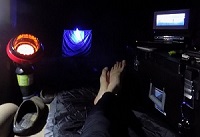
- Premium Member - 2024

- Posts: 323
- Joined: Mon May 23, 2022 5:06 pm
Re: Using absolutes: always, never
by kevinkk » Wed Apr 03, 2024 3:39 pm
the old saying is the only certainties in life are death and taxes, I would argue that taxes are not a certainty, and we can only count on expiration.
An interesting observation, and an issue fixed with proper language and grammar, in their correct context.
-
vabrou

- Posts: 92
- Joined: Mon May 23, 2022 11:22 am
Re: butterfly bait trap
by vabrou » Wed Apr 03, 2024 3:32 pm
To answer your question you will find what species was captured at UV light and which species were attracted to bait in that study. We captured e.g. all the normally considered dayflying species of hawk-moths occurring in Louisiana using our UV light traps (night collecting). From our 26-year portion publication we reported species more often taken in fermenting bait traps included Sphinx kalmiae Neurn., Enyo lugubris (L.), Sphecodina abhottii (Swainson), A. floridensis, Darapsa myron, and Darapsa pholus (Cram.). We captured several specimens each of species not generally known to be attracted to fermenting bait were taken by this method, including Laothoe juglandis (J. E. Smith), Hemaris diffinis , Darapsa versicolor (Harr.), and Xylophones tersa (L.). Several Agrius cingulata (F.) and Amphion floridensis were captured in pitfall traps baited with a mixture of human feces, water, and ethylene glycol. Interesting about L. juglandis as adults of this species have been incorrectly reported in the past scientific literature as having non-functioning feeding mouth parts.
Our bait recipes included any an all available fruits of the week (whatever was available to us at any given moment), e.g. bananas, peaches, apples, pears, apricots, cherries, blueberries..... were more readily available These were blended along with granulated sugar and/or cane syrup, etc.... and added cheap regular strength alcohol beer. Never use light beer and never, never, never use honey as it will immediately destroy your bait. We placed the blended bait into used plastic empty milk jugs which allowed easy handling and easily poured bait. The attached photo shows a series of a bi-colored cerambycid beetle (Purpuricenus axillaris Haldeman) which all were captured using banana baits only, none by any other trap methods or any other baits. Showing that experimentation produces unexpected results. Here is another cerambycidae I captured using fermenting fruit bait: Plinthocoelium suaveolens (Linnaeus)
While I'm thing about pouring bait, this same concept works exceptionally well for using (human) dung- easily handled using funnels and easily poured at trap locations using non-chlorinated water pre-added to the dung and then stored for use. NEVER< NEVER< NEVER tightly close lids on any fermenting baits, including especially dung. Never ever store fermenting fruit or fresh dung inside of your home or any buildings.
Here are the three free access links to our Sphingidae of Louisiana publications:
https://www.academia.edu/232102/Distrib ... Sphingidae
https://www.academia.edu/1021607/Addend ... _Louisiana
https://www.academia.edu/1509724/Second ... _Louisiana
and many others can be found on that same site freely accessible. https://independent.academia.edu/VernonAntoineBrouJr
- Attachments
-
- DSCF0040 use this one.jpg (267.7 KiB) Viewed 166 times
-
- DSCF2334 red.jpg (707.27 KiB) Viewed 166 times
-
58chevy

- Posts: 379
- Joined: Mon May 23, 2022 5:58 pm
Re: Using absolutes: always, never
by 58chevy » Wed Apr 03, 2024 3:14 pm
-
vabrou

- Posts: 92
- Joined: Mon May 23, 2022 11:22 am
Re: butterfly bait trap
by vabrou » Wed Apr 03, 2024 1:41 pm
Lid is glass. Reason for glass is so captured insects see bright light and go to it assuming that is an exit. This concept works exceptionally well. The circular tray holding captures easily lifts out, and under the tray is the NaCn killing agent. What was most surprising is the addition of the 1/4" mesh hardware cloth to the outer diameter of the wooden circular tray prevented 99+% of the tiniest insects from passing through this mesh. This same 1/4" mesh flexible hardware cloth is also the perfect material to create the inverted funnel attached to the bottom of the collection chamber (see image).
The outer (white) rings are obtained buy cutting rings out of 50 gallon plastic drums. I do not recommend smaller diameter ring. I experimented several times using smaller diameter rings - poor results.
Top image from about 40 years ago illustrates live capture bait trap (A) next to two early iterations of my bait traps with attached collection chambers (B and C). In all three of these (A,B,C) the screen material is flexible fiberglass 1/8" mesh. Never use steel or aluminum or plastic coated steel as screening material. The steel will rust away and the aluminum is easily chewed by wasps. When used, steel zippers with rust away.
- Attachments
-
- My bait traps 1980's , Abita Springs, La.jpg (89.65 KiB) Viewed 176 times
-
- Bait trap with collection chamber close.jpg (194.78 KiB) Viewed 176 times
-
- DSCF0004 (800MP).JPG (420.16 KiB) Viewed 176 times
-
Chuck

- Premium Member - 2024

- Posts: 903
- Joined: Mon May 23, 2022 2:30 pm
Re: butterfly bait trap
by Chuck » Wed Apr 03, 2024 12:02 pm
-
vabrou

- Posts: 92
- Joined: Mon May 23, 2022 11:22 am
Re: butterfly bait trap
by vabrou » Tue Apr 02, 2024 3:17 pm
You can also place other types of traps nearby your bait traps e.g., light traps, semiochemical lure traps , dung beetle traps, on and on..... This is how I ended up running ~500 insect traps over the past half century. This way you can run these multiple traps more efficiently (time-wise) 4-5 traps at a time instead of one trap at a location stop. Using bait traps allowed capture of as many as 500+ butterflies or 500+ catocala per trap, per day, during the warmer months without the presence of the collector.
If you plan on running a lot of bait traps over many years, consider what i did early on, I planted 160+ fruit trees: apple, pears, peaches, plums, etc.....so I could have easy no-cost access to bait. As a consequence, it also supplied considerable fresh fruit for my family and friends for decades.
Attached photo is one of my many automatic capture bait traps here at my home in Louisiana. This trap uses cyanide for dispatching all insects of any type entering the trap 24 hours daily, thus resulting in the highest possible quality specimens without the presence of the collector, except to pick up the results. Except for some live-capture bait traps, I have incorporated ethyl acetate or Sodium cyanide as a dispatching agent in >95% of the 500 insect traps I have operated. This type of trapping allowed me to be employed full time, have a family, go to college, publish 654 entomological research papers using the specimens I collected, and my wife and I have discovered over 400 species of moths new to science (our target insects), and I have a life without being involved in the time-consuming activities required using classical collecting methods.
- Attachments
-
- 2008 bait trap 2 with collection chamber inet.jpg (721 KiB) Viewed 235 times
-
Chuck

- Premium Member - 2024

- Posts: 903
- Joined: Mon May 23, 2022 2:30 pm
Using absolutes: always, never
by Chuck » Tue Apr 02, 2024 3:07 pm
"You NEVER run the vacuum!" This is hyperbole; I ran the vacuum two months ago.
And so, in research discussions one will rarely see "always", "never", or other absolutes. One cannot accurately say, for example, that a Goliath beetle has never been caught in USA, because one was. Is it safe to say that Goliath beetles do NOT occur in North America? Probably, from what we know, that capture probably came in a bunch of fruit. But a negative cannot be disproven.
I recently came across this in another field of research- an artifact was presented with what is obviously(?) in an incorrect characteristic. Or is it? It's possible that it is correct, and a lot of established views are going to be turned upside-down.
Is it fair then to simply avoid the absolute by rephrasing? "Papilio multicaudata is ONLY found west of the Mississippi" becomes "Papilio multicaudata is found west of the Mississippi"....yet the "ONLY" is implied.
Where there is any ambiguity, even the tiniest bit, then what? If we use "almost always" and "as known to date" and such, publications would be inundated with these caveat words.
So what to do?
-
wollastoni

- Site Admin

- Posts: 461
- Joined: Fri Mar 18, 2022 9:51 am
Re: Limenitis chrysalides
by wollastoni » Tue Apr 02, 2024 1:18 pm
-
Chuck

- Premium Member - 2024

- Posts: 903
- Joined: Mon May 23, 2022 2:30 pm
Re: Tiger Swallowtails of NY: Finger Lakes, Part II
by Chuck » Tue Apr 02, 2024 12:25 pm
Ironically, despite the taxa being large, showy, and first described by Linnaeus some two hundred and sixty-six years ago, I cannot with any certainty map the ranges of the Tiger taxa. Part of it is because the Lep community didn't discern between some taxa for lengthy periods, part because it takes a specialist (and even genetics) to determine the correct taxon, and part because oddly enough there are insufficient specimens from some large areas.
Outstanding as an example (to my mind at least) are the dozens of "early flight" Tigers captured by Hagen & Lederhouse in 1972 and 1973 in the Ithaca, NY (Cornell) area...are these "spring flight" or canadensis? The specimens are not in the Cornell collection. Robert Hagen responded to an initial inquiry on this work, which he has apparently put behind him, and no longer responds to queries. So what are the "early flight" Tigers near Cornell? For that matter, we now know that the "Late Flight" of Hagen & Lederhouse studies are the Mid Summer Tiger and NOT Papilio glaucus...but what ARE "spring form"? That can only be determined by genetic tests which haven't been conducted.
So I turned to historical records in the form of publications. These are largely limited to what I have on hand. The following tracks published range descriptions and later, maps. Notable events in taxonomy are in red. My personal reflections are in blue.
Papilio turnus Linnaeus 1758
Papilio glaucus maynardi, Gauthier, 1891
The Butterfly Book, Holland, 1905. (as turnus)
“Appalachian ranges at comparatively low leves…southwestern Pennsylvania, the Virginias, the Carolinas, Kentucky, and Tennessee…New England…Gulf states”
Papilio glaucus canadensis, Rothschild & Jordan, 1906
Butterflies Worth Knowing, Weed, 1917.
“from ocean to ocean”
How to Know the Butterflies, Comstock 1943
“nearly all parts of the United States and Canada”
A Field Guide to the Butterflies of North America, East of the Great Plains, Klots, 1951. “Hudsonian zone in Canada s. through Florida, and Texas, scarcer at southern limits”
Butterflies of Virginia, Clark & Clark, 1951.
“sub-artic regions…from southern New England to North Carolina…New England…Quebec and New Brunswick…Virginia, West Virginia, Kentucky, southern Illinois and central Nebraska…northern Ohio, southern Wisconsin, central Iowa, and South Dakota…Newfoundland and southern Alberta…British Colombia…throughout the whole of Canada…Montana…New Hampshire…Newfoundland…Maryland” nothing about southern states, focus on region-specific variations inc. canadensis
Clark & Clark spend many pages exploring various morphological traits of Tiger Swallowtails throughout North America. One could map them, though it's spotty. Some of these "forms" have turned out to be nothing, while at they same time they are the first to mention a flight between "Spring Form" and "Summer Form"
The Butterflies of North America, Howe, 1975.
“(canadensis) Alaska, Canada, Newfoundland and the northern mountainous parts of New England and New York…(glaucus) New England to Wisconsin southward to Texas, Louisiana, Alabama and Georgia…australis…Forida and the coastal plain areas of Georgia west to Louisiana and possibly extreme eastern Texas”
Butterflies of the World, Klots, 1976
no range provided
The Audubon Society Field Guide to North American Butterflies, Pyle, 1981.
“Central Alaska and Canada to Atlantic, southeast of Rockies to Gulf. “
Butterflies East of the Great Plains, Opler & Krizek, 1984.

The Butterflies of North America, Scott, 1986.

Papilio canadensis, Hagen, 1991
Now that canadensis has been described as a distinct species, subsequent publications (books) should follow suit- but the don't.
Slopp work.
Butterflies of North America, Feltwell, 1992 reprint
“Most of North America and Alaska, except within Artic Circle”
Butterflies and Moths, Carter, 1992.
“throughout Canada and the USA, to the Gulf of Mexico”
A Field Guide to Eastern Butterflies, Opler, 1992 (Peterson Field Guides)

Ironically, if you compare Opler's two range maps you'll see there are no Tiger Swallowtails in NY south of Lake Ontario- the Finger Lakes region, my primary Tiger research area!
Butterflies through Binoculars, Assberg, 1993.
“Entire region. Also north to Canada and west to Alaska and Texas”
At this point, I turn to mostly publications in periodicals. The most up-to-date info here on is specific (usually) to Tiger Swallowtails and conducted by Scriber
Genetics of Mimicry in the Tiger Swallowtail Butterflies, Papilio glaucus and P. canadensis, Scriber, Hagen, Lederhouse, 1996.
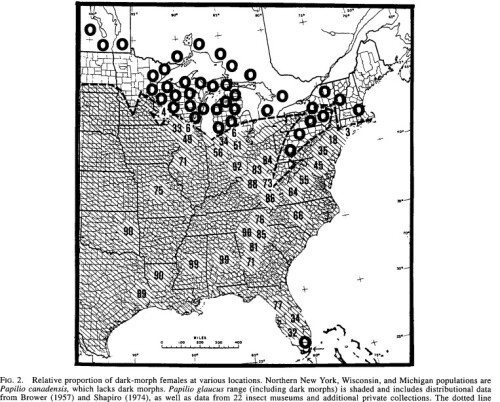
Circles are "hybrids", "late flight", potentially what would be known as "MST"
Papilio appalachiensis, Pavulaan, 2002
Pterourus appalachiensis (Papilionidae: Papilioninae), an new swallowtail from the Appalachian region of the United States, Pavulaan & Wright, 2002.
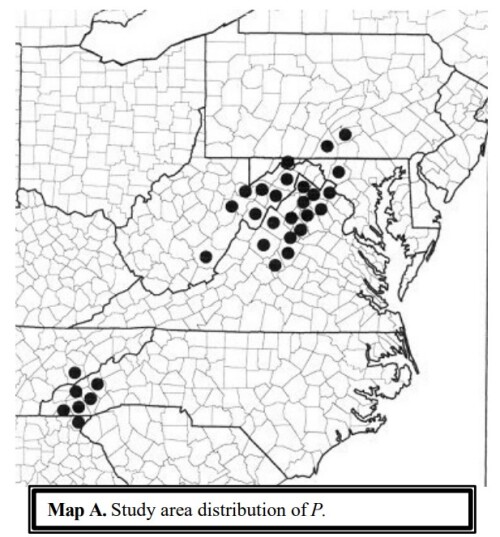
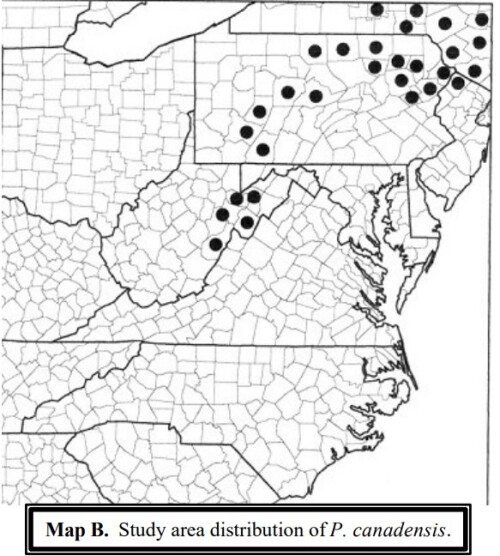
Note that in the paper Pavulaan & Wright do discuss Tigers that are morphologically similar or identical to appalachiensis observed/ captured all up the eastern seaboard
The Field Guide to Butterflies, Daniel & Southby, 2003.
“Appalachian uplift; but ranges northwestward to Alaska and south to the Gulf States…Alaskan form now classified as Papilio canadensis”
Impacts of climate warming on hybrid zone movement: Geographically diffuse and biologically porous “species borders” Scriber, 2010
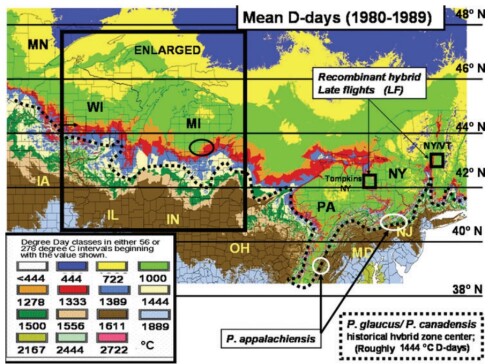
Sex Chromosome Mosaicism and Hybrid Speciation among Tiger Swallowtail Butterflies, Kunte & Scriber et al, 2011

According to this map, the hybrid/ MST (grey) do meet appalachiensis in PA. Whether they do or not is TBD.
The “Converse to Germann’s Rule” in Tiger Swallowtail Butterflies, Lehnert, Scriber et al. 2012
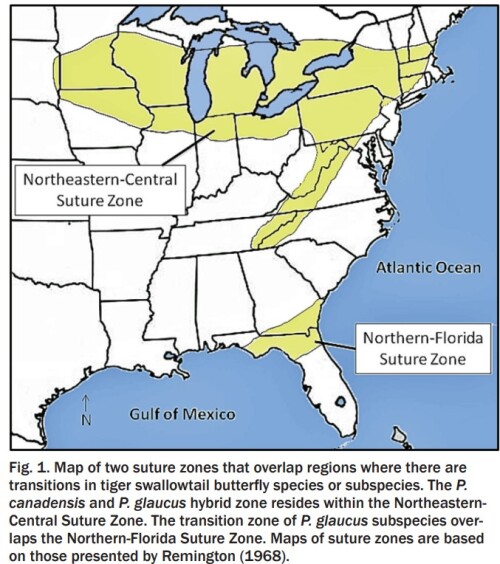
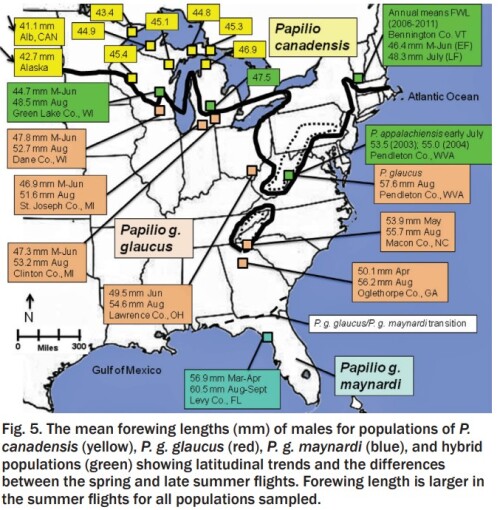
Climate-Driven Reshuffling of Species and Genes: Potential Conservation Roles for Species Translocations and Recombinant Hybrid Genomes, Scriber 2014
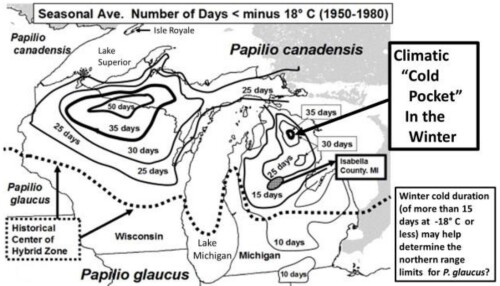
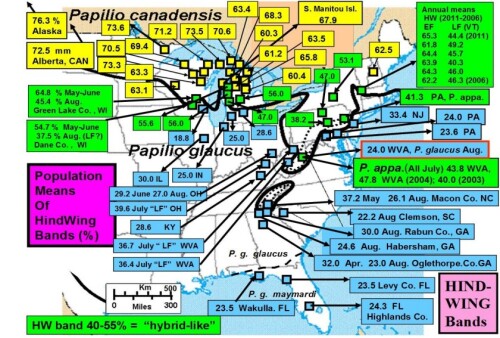

The last of the three maps is about the closest to what I've mapped. I am dubious about glaucus ocurring in/ near Buffalo NY; that said I have been a disbeliver that the only-yellow morph of the females is glaucus or that glaucus occurs near Toronto Canada but Schmidt and Wang have assured me specimens have been genetically tested and are glaucus.
~2019 "Mid Summer Tiger Swallowtail" (MST) coined by Canadians
More on Ontario Tiger Swallowtails, Schmidt, 2019
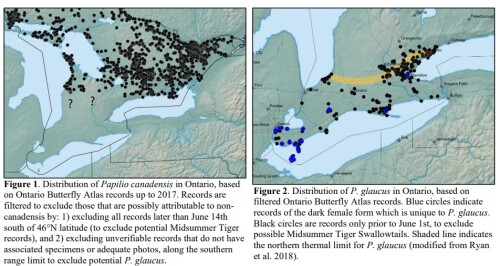
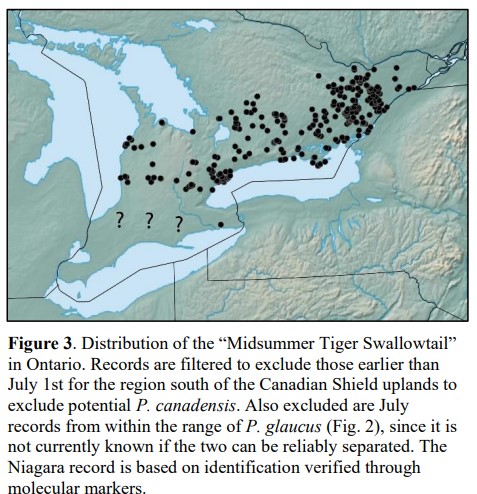
The Canadian researchers have been serious about this hybrid MST for some years now, as can be seen above. Unfortunately, their research stops at the political border, and virtually nobody (except me) seems to be studying in NY.
Assessing ecological and physiological costs of melanism in North American Papilio glaucus females: two decades of dark morph frequency declines, Scriber 2020
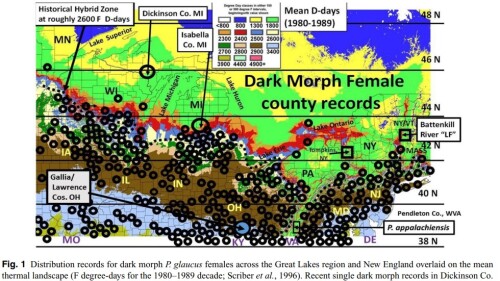
Circles are captures of dark females. What remains north of those captures is unknown- yellow/yellow glaucus or MST, or what.
Tiger Swallowtails: Making Observations in 2020, Mcnaughton, 2020


More specifics on MST in Ontario Canada
Gauging ages of tiger swallowtail butterflies using alternate SNP analyses, Vernygora, 2022
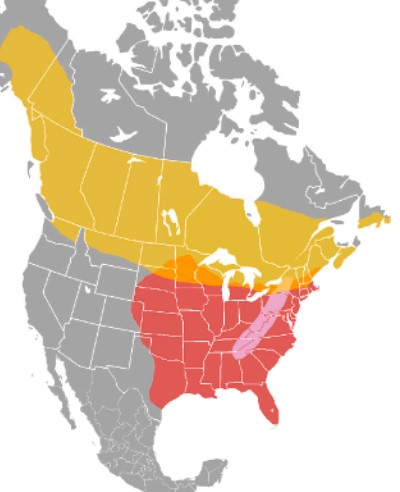
Note in this late map, appalachiensis runs through MST and deep into canadensis! The map is rather ambiguous though, I have the genetic data from which it's compiled and there are great wholes (geographically, temporally)
iNaturalist, captured 28march2024
All eastern Tiger Swallowtail observations/data should be considered highly suspect, as the identification error rate for some areas/periods runs as high as 100%. BOLD is no better.
canadensis
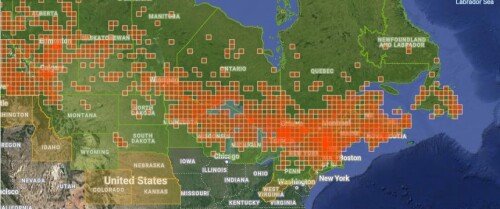
glaucus
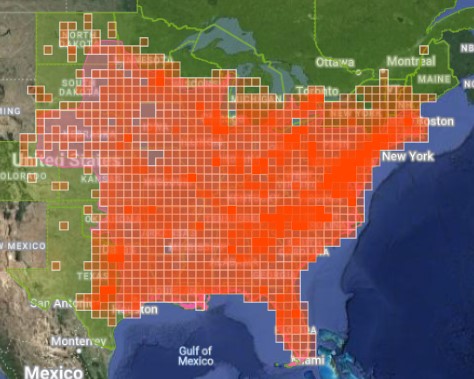
Appy

MST
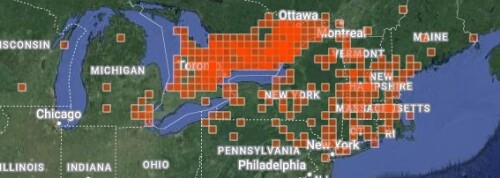
-
wollastoni

- Site Admin

- Posts: 461
- Joined: Fri Mar 18, 2022 9:51 am
Re: Agrias butterflies
by wollastoni » Tue Apr 02, 2024 10:27 am
Available in the InsectNet marketplace.
-
vabrou

- Posts: 92
- Joined: Mon May 23, 2022 11:22 am
Re: butterfly bait trap
by vabrou » Tue Apr 02, 2024 12:17 am
Here are 57 freely accessible publications concerning 'bait traps' https://independent.academia.edu/search?q=bait%20traps
Vernon
-
vabrou

- Posts: 92
- Joined: Mon May 23, 2022 11:22 am
Re: butterfly bait trap
by vabrou » Mon Apr 01, 2024 11:31 pm
I initially designed my trap to attract and capture large quantities of hawkmoths and catocala, and my traps worked exceptionally well. Myself, I operated my various bait traps in the same locations for several decades 52 weeks every year. I averaged for example capturing around 40,000 butterflies annually (not my target insects), operating them in the very same exact locations without relocating them for decades. Despite operating my traps in the same locations continuously, they are a considerable improvement over the ones you mention. Here are two freely accessible links to my published instructions. My traps are not necessarily portable.
https://www.academia.edu/24752124/EXTEN ... _ROUND_USE
https://www.academia.edu/24752306/Fabri ... ng_chamber
Vernon
- Attachments
-
- DSCF0005 e.jpg (111.62 KiB) Viewed 262 times
-
Annarobertson1947

- Posts: 68
- Joined: Thu May 04, 2023 12:31 am
Re: Agrias butterflies
by Annarobertson1947 » Mon Apr 01, 2024 7:07 am
Hi Wollastoni, a question for you .wollastoni wrote: ↑Sat Nov 26, 2022 10:17 amDave, the correct ID of your second Agrias is a Agrias claudina lugina form orleansi.
Please note that "sardanapalus" is a ssp of claudina (from Iquitos, Venezualian Amazonas, Brazilian Amazonas & Rondonia)
Please note that "godmani" is a ssp of claudina too (from Mato Grosso).
As Agrias is a very complex group (with a lot of hybridization and forms), there are a lot of errors in books and collections.
If I had to recommend one book to start studying them, Manfred Späth's monography about Agrias is the best one and it is not expensive at all.
Then to better understand forms, Floquet's volumes are a must (but hard to find).
I see Floquets books as stated being 2 books.
But on insectnet market place see attachment, 2023 book.
As I'm in the need of his book/ books, is this 2023 publication covering all species/ subspecies and forms ?
Thanks in advance
Anna
- Attachments
-
- Screenshot_20240401-175428_Chrome.jpg (43.04 KiB) Viewed 307 times
-
lamprima2
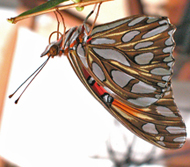
- Premium Member - 2024

- Posts: 92
- Joined: Mon May 23, 2022 8:16 pm
-
papilio7119

- Posts: 1
- Joined: Sat Mar 30, 2024 3:21 pm
butterfly bait trap
by papilio7119 » Sat Mar 30, 2024 3:31 pm
